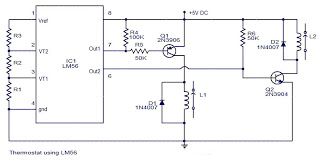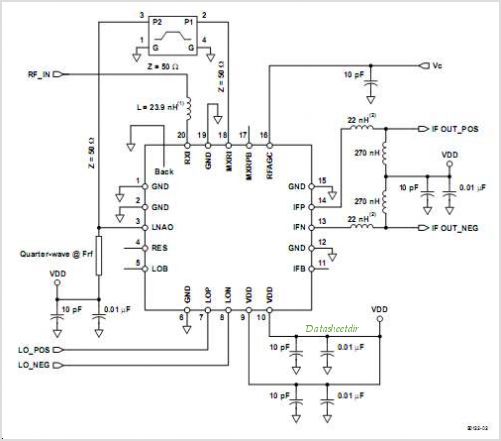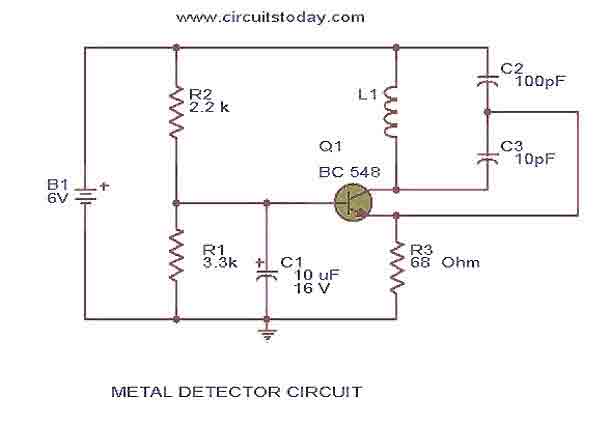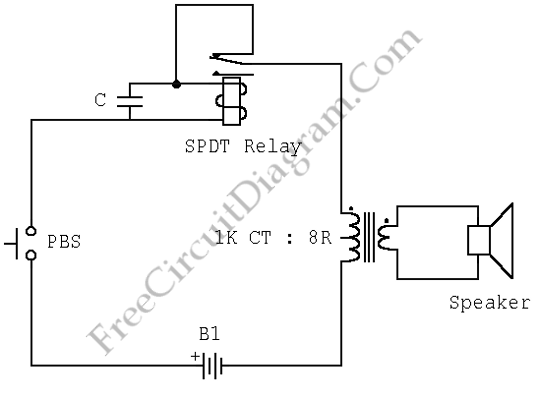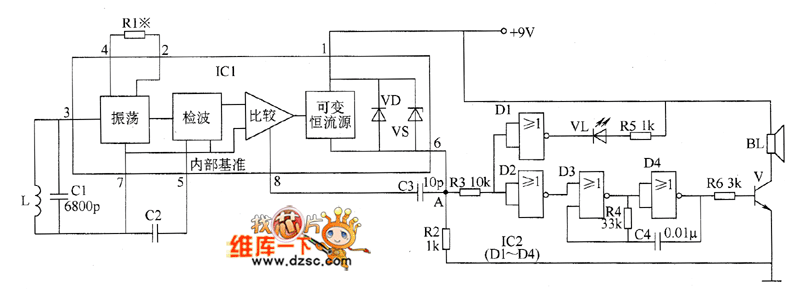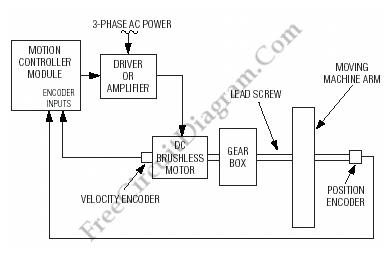
Audio Simple Sound-to-Light Converter Schematic Diagram
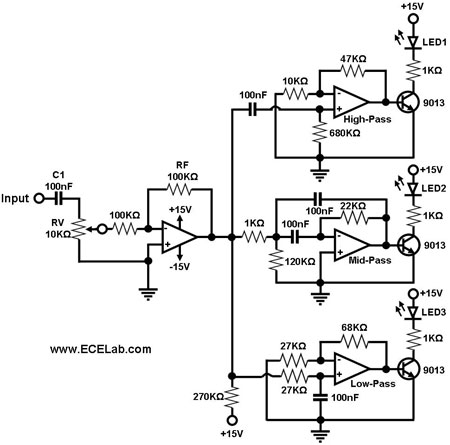
Figure 1 illustrates a simple circuit designed for converting an audio signal (such as one from the output terminals of a CD player). The circuit primarily consists of a buffer/amplifier stage and three filtering circuits: a high-pass filter, a band-pass filter, and a low-pass filter. The output of each filter drives a light-emitting diode (LED) of different colors. The input signal is fed to the buffer stage through capacitor C1. The values of resistors RF and RV1 should be selected to ensure that the buffer can adequately drive the three filters connected to its output. The low-frequency, mid-frequency, and high-frequency components of the input signal are allowed to pass through the low-pass filter (bottom filter), the band-pass filter (middle filter), and the high-pass filter (top filter), respectively, effectively separating them from each other. Variations in the output of a filter cause its corresponding LED to turn on and off. Consequently, applying a continuous audio signal to the input of this circuit results in the LEDs appearing to "dance."
The circuit design begins with a buffer/amplifier stage, which is essential for isolating the input audio signal from the subsequent filtering stages. The buffer ensures that the audio source is not loaded down by the filters, maintaining signal integrity. The capacitor C1 is crucial for coupling the audio signal while blocking any DC offset that may be present.
Following the buffer, the circuit branches into three distinct filtering paths. The low-pass filter is designed to allow signals below a certain cutoff frequency to pass through while attenuating higher frequencies. This is typically achieved using a combination of resistors and capacitors configured in an RC network. The output of the low-pass filter is connected to an LED that illuminates in response to bass frequencies.
The band-pass filter, situated in the middle path, is engineered to pass a specific range of frequencies, effectively allowing mid-range audio signals to be processed. This filter is often implemented using a more complex arrangement of components to ensure that both the lower and upper cutoff frequencies are precisely defined. The corresponding LED for this filter responds to mid-range frequencies, providing visual feedback on the audio signal's presence in that frequency band.
The high-pass filter, located at the top of the circuit, permits signals above a certain frequency to pass while blocking lower frequencies. Similar to the low-pass filter, this is achieved through an RC network, and its output drives an LED that lights up in response to treble frequencies.
The interaction of these filters with the audio signal creates a dynamic visual representation of the audio content. As the audio signal varies, the corresponding LEDs flicker in intensity, creating a captivating effect that reflects the frequency content of the music. This circuit can be used in various applications, including visualizers for audio systems, decorative lighting, or educational demonstrations of audio frequency response. Proper selection of component values is crucial for achieving the desired performance and ensuring that the circuit operates effectively across the intended frequency ranges.Figure 1 shows a simple ambit for converting an audio arresting (such as one that comes from the apostle terminals of a CD player). The ambit basically consists of a buffer/amplifier date and three clarify circuits: a high-pass filter, a mid-pass filter, and a low-pass filter.
The achievement of anniversary clarify ambit drives a light-emitting di ode of altered color. The ascribe arresting is fed to the absorber date through C1. The ethics of RF and RV1 should be called so that the absorber is able to drive the three filters absorbed to its output. The low-frequency, mid-frequency, and high-frequency apparatus of the ascribe arresting are alone accustomed to canyon through the low-pass clarify (bottom filter), the mid-pass clarify (middle filter), and the high-pass clarify (topmost filter), respectively, appropriately amid them from anniversary other.
Changes in the achievement of a clarify account its agnate achievement LED to about-face on and off. In effect, agriculture a connected audio arresting to the ascribe of this ambit causes the LED`s to `dance`. 🔗 External reference
The circuit design begins with a buffer/amplifier stage, which is essential for isolating the input audio signal from the subsequent filtering stages. The buffer ensures that the audio source is not loaded down by the filters, maintaining signal integrity. The capacitor C1 is crucial for coupling the audio signal while blocking any DC offset that may be present.
Following the buffer, the circuit branches into three distinct filtering paths. The low-pass filter is designed to allow signals below a certain cutoff frequency to pass through while attenuating higher frequencies. This is typically achieved using a combination of resistors and capacitors configured in an RC network. The output of the low-pass filter is connected to an LED that illuminates in response to bass frequencies.
The band-pass filter, situated in the middle path, is engineered to pass a specific range of frequencies, effectively allowing mid-range audio signals to be processed. This filter is often implemented using a more complex arrangement of components to ensure that both the lower and upper cutoff frequencies are precisely defined. The corresponding LED for this filter responds to mid-range frequencies, providing visual feedback on the audio signal's presence in that frequency band.
The high-pass filter, located at the top of the circuit, permits signals above a certain frequency to pass while blocking lower frequencies. Similar to the low-pass filter, this is achieved through an RC network, and its output drives an LED that lights up in response to treble frequencies.
The interaction of these filters with the audio signal creates a dynamic visual representation of the audio content. As the audio signal varies, the corresponding LEDs flicker in intensity, creating a captivating effect that reflects the frequency content of the music. This circuit can be used in various applications, including visualizers for audio systems, decorative lighting, or educational demonstrations of audio frequency response. Proper selection of component values is crucial for achieving the desired performance and ensuring that the circuit operates effectively across the intended frequency ranges.Figure 1 shows a simple ambit for converting an audio arresting (such as one that comes from the apostle terminals of a CD player). The ambit basically consists of a buffer/amplifier date and three clarify circuits: a high-pass filter, a mid-pass filter, and a low-pass filter.
The achievement of anniversary clarify ambit drives a light-emitting di ode of altered color. The ascribe arresting is fed to the absorber date through C1. The ethics of RF and RV1 should be called so that the absorber is able to drive the three filters absorbed to its output. The low-frequency, mid-frequency, and high-frequency apparatus of the ascribe arresting are alone accustomed to canyon through the low-pass clarify (bottom filter), the mid-pass clarify (middle filter), and the high-pass clarify (topmost filter), respectively, appropriately amid them from anniversary other.
Changes in the achievement of a clarify account its agnate achievement LED to about-face on and off. In effect, agriculture a connected audio arresting to the ascribe of this ambit causes the LED`s to `dance`. 🔗 External reference
Warning: include(partials/cookie-banner.php): Failed to open stream: Permission denied in /var/www/html/nextgr/view-circuit.php on line 713
Warning: include(): Failed opening 'partials/cookie-banner.php' for inclusion (include_path='.:/usr/share/php') in /var/www/html/nextgr/view-circuit.php on line 713
